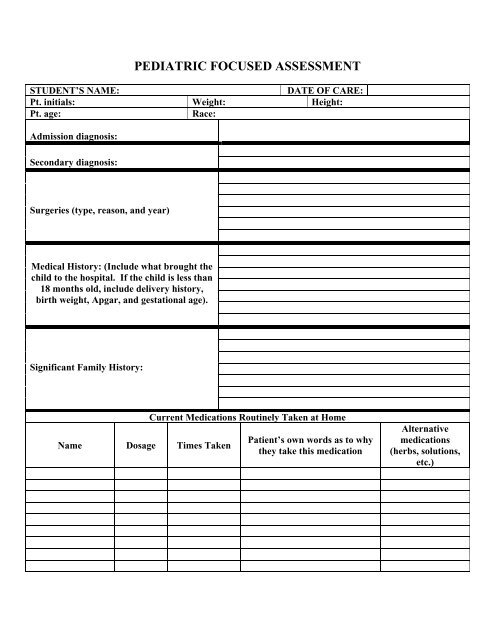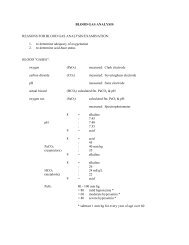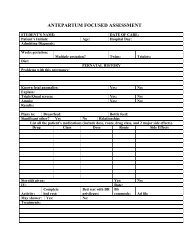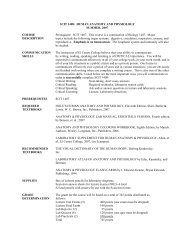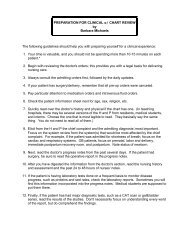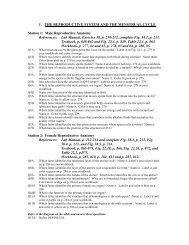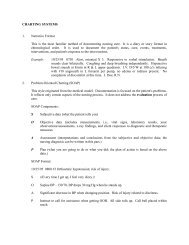PEDIATRIC FOCUSED ASSESSMENT.pdf
PEDIATRIC FOCUSED ASSESSMENT.pdf
PEDIATRIC FOCUSED ASSESSMENT.pdf
You also want an ePaper? Increase the reach of your titles
YUMPU automatically turns print PDFs into web optimized ePapers that Google loves.
<strong>PEDIATRIC</strong> <strong>FOCUSED</strong> <strong>ASSESSMENT</strong><br />
STUDENT’S NAME:<br />
DATE OF CARE:<br />
Pt. initials: Weight: Height:<br />
Pt. age:<br />
Race:<br />
Admission diagnosis:<br />
Secondary diagnosis:<br />
Surgeries (type, reason, and year)<br />
Medical History: (Include what brought the<br />
child to the hospital. If the child is less than<br />
18 months old, include delivery history,<br />
birth weight, Apgar, and gestational age).<br />
Significant Family History:<br />
Name Dosage Times Taken<br />
Current Medications Routinely Taken at Home<br />
Patient’s own words as to why<br />
they take this medication<br />
Alternative<br />
medications<br />
(herbs, solutions,<br />
etc.)
<strong>PEDIATRIC</strong> <strong>FOCUSED</strong> <strong>ASSESSMENT</strong> Page 2<br />
Student’s Name:<br />
What is the most life-threatening problem for this patient (Think ABC’s – this should always be our #1<br />
diagnosis).<br />
What is the most significant emotional issue for this child and/or family<br />
1.<br />
If this patient is experiencing pain, list two ways to provide pain relief without using medications.<br />
2.<br />
Which pain assessment tool did you use<br />
Explain why you chose this pain assessment tool<br />
FLACC 0-5 0-10<br />
Faces NIPS PIPS<br />
Other<br />
What pain medication did you administer, and what was its effect<br />
Procedures/X-rays/Ultrasound/MRI/EKG, etc. while hospitalized, (date and results).
<strong>PEDIATRIC</strong> <strong>FOCUSED</strong> <strong>ASSESSMENT</strong> Page 3<br />
Student’s Name:<br />
Significant lab results with date:<br />
Child’s Values Normal Values Rationale for abnormal values<br />
Equipment used (such as cardiac monitor, pulse OX, etc.):<br />
Fluid Assessment:<br />
IV Fluids: (calculate on all patients, even if they do not have an IV)<br />
Calculating Daily Maintenance Fluid Rates<br />
< 10 kg 100 ml/kg<br />
10 – 20 kg 1000 ml + 50 ml/kg for each additional kg between 10 and 20 kg<br />
20 + kg 1500 ml + 20 ml/kg for each additional kg over 20 kg<br />
Calculated IV fluid intake: Per 24 hours:<br />
Per hour:<br />
Type IVF infusing:<br />
Rate infusing:<br />
Shift intake:<br />
Heplock: Yes No<br />
Central line:<br />
Type:<br />
Site:<br />
Condition of site:<br />
Dressing change:<br />
Diet type:<br />
Formula: Frequency: Shift intake:<br />
NG feedings: Type: Rate: Shift intake:<br />
G Button Feedings: Type: Rate: Shift intake:<br />
Output:<br />
Calculated output (0.5-2 ml/kg/hr or day) Per Day: Per Hour:<br />
Urine: Output Volume ml:<br />
# Diapers:<br />
Sp. Gravity: Protein: Glucose:<br />
Stools: # in last 24 hours:<br />
Guiac:<br />
Other:
<strong>PEDIATRIC</strong> <strong>FOCUSED</strong> <strong>ASSESSMENT</strong> Page 4<br />
Student’s Name:<br />
Medications:<br />
Dose: Route: Times:<br />
Weight of Child in KG:<br />
Calculate dose range: (high and low)<br />
Reference used for dosage range:<br />
Drugs low dose:<br />
Drugs high dose:<br />
Child’s low dose:<br />
Child’s high dose:<br />
Is this a safe dose for this child Yes: No:<br />
Classification of Drug:<br />
Indication of Drug:<br />
Possible adverse reactions:<br />
Drug:<br />
Dose: Route: Times:<br />
Weight of Child in KG:<br />
Calculate dose range: (high and low)<br />
Reference used for dosage range:<br />
Drugs low dose:<br />
Drugs high dose:<br />
Child’s low dose:<br />
Child’s high dose:<br />
Is this a safe dose for this child Yes: No:<br />
Classification of Drug:<br />
Indication of Drug:<br />
Possible adverse reactions:<br />
Drug:<br />
Dose: Route: Times:<br />
Weight of Child in KG:<br />
Calculate dose range: (high and low)<br />
Reference used for dosage range:<br />
Drugs low dose:<br />
Drugs high dose:<br />
Child’s low dose:<br />
Child’s high dose:<br />
Is this a safe dose for this child Yes: No:<br />
Classification of Drug:<br />
Indication of Drug:<br />
Possible adverse reactions:
<strong>PEDIATRIC</strong> <strong>FOCUSED</strong> <strong>ASSESSMENT</strong> Page 5<br />
Student’s Name:<br />
Drug:<br />
Dose: Route: Times:<br />
Weight of Child in KG:<br />
Calculate dose range: (high and low)<br />
Reference used for dosage range:<br />
Drugs low dose:<br />
Drugs high dose:<br />
Child’s low dose:<br />
Child’s high dose:<br />
Is this a safe dose for this child Yes: No:<br />
Classification of Drug:<br />
Indication of Drug:<br />
Possible adverse reactions:<br />
Drug:<br />
Dose: Route: Times:<br />
Weight of Child in KG:<br />
Calculate dose range: (high and low)<br />
Reference used for dosage range:<br />
Drugs low dose:<br />
Drugs high dose:<br />
Child’s low dose:<br />
Child’s high dose:<br />
Is this a safe dose for this child Yes: No:<br />
Classification of Drug:<br />
Indication of Drug:<br />
Possible adverse reactions:<br />
Drug:<br />
Dose: Route: Times:<br />
Weight of Child in KG:<br />
Calculate dose range: (high and low)<br />
Reference used for dosage range:<br />
Drugs low dose:<br />
Drugs high dose:<br />
Child’s low dose:<br />
Child’s high dose:<br />
Is this a safe dose for this child Yes: No:<br />
Classification of Drug:<br />
Indication of Drug:<br />
Possible adverse reactions:
<strong>PEDIATRIC</strong> <strong>FOCUSED</strong> <strong>ASSESSMENT</strong> Page 6<br />
Student’s Name:<br />
Pediatric Growth and Development Assessment<br />
Patient’s age:<br />
Include a brief description of each stage and the patient specific criteria for each stage. (What does the<br />
textbook say and how does your specific patient meet these criteria).<br />
Eriksson’s Stage of Psychosocial development for this child:<br />
Patient’s Stage:<br />
Plaget’s Stage of Cognitive Development:<br />
Patient’s Stage:<br />
Typical fears and/or issues of this age:<br />
Patient’s stage:<br />
Growth Assessment:<br />
(Plot on growth charts in Nursing Care of Children, pages 1069-1072)<br />
Height:<br />
Weight:<br />
What does this assessment indicate<br />
% on growth chart:<br />
% on growth chart:<br />
Gross Motor:<br />
Normal assessment for this age:
<strong>PEDIATRIC</strong> <strong>FOCUSED</strong> <strong>ASSESSMENT</strong> Page 7<br />
Student’s Name:<br />
Observed assessment:<br />
Fine Motor:<br />
Normal Assessment:<br />
Observed Assessment:<br />
Language/Communication:<br />
Normal Assessment:<br />
Observed Assessment:<br />
Socialization:<br />
Normal Assessment:<br />
Observed Assessment:<br />
Characteristics of Play:<br />
Normal Assessment:
<strong>PEDIATRIC</strong> <strong>FOCUSED</strong> <strong>ASSESSMENT</strong> Page 8<br />
Student’s Name:<br />
Observed Assessment:<br />
Appropriate Toys:<br />
List of toys for this age group:<br />
Toys this patient used:<br />
Bibliography:
<strong>PEDIATRIC</strong> <strong>FOCUSED</strong> <strong>ASSESSMENT</strong> Page 8<br />
Student’s Name:<br />
<strong>PEDIATRIC</strong><br />
PHYSICAL <strong>ASSESSMENT</strong><br />
<strong>ASSESSMENT</strong> PARAMETERS<br />
A"√” . (check mark) in the box indicates<br />
congruence with<br />
the assessment standards for each system. An "E"<br />
indicates a baseline assessment standard for an<br />
individual patient that reflects an exception to the<br />
assessment standard. An .**(asterisk) in the box<br />
indicates a finding that indicates a deviation from<br />
both<br />
the assessment standard and the patient's baseline<br />
and<br />
requires further elaboration in the boxes to the right.<br />
Neurological Assessment<br />
Alert and/or arouses easily. Oriented to person and<br />
place, no change in usual behavior. No c/o dizziness,<br />
numbness, tingling, pain, headache, seizures, memory<br />
loss, insomnia, loss of consciousness. No paralysis<br />
noted. Pupils equal and react to light. Speech dear for<br />
age. No evidence of hearing or vision loss. Fontanel soft<br />
and flat as appropriate for age.<br />
Cardiovascular Assessment<br />
Blood pressure, heart rate within normal limits for age.<br />
Regular rhythm with no murmur noted. Nail beds pink<br />
without clubbing. Capillary refill time less than or equal<br />
to<br />
3 seconds. No edema or cyanosis noted. No c/o pain.<br />
Peripheral pulses palpable and equal. No history of blood<br />
Transfusions.<br />
Respiratory Assessment<br />
Bilateral breath sounds clear throughout lung fields.<br />
Respirations unlabored, symmetrical and regular with a<br />
rate normal for age. No retractions, nasal flaring,<br />
splinting, dyspnea, stridor or cough. No c/o pain.<br />
Gastrointestinal Assessment<br />
Abdomen soft, non-distended with active bowel sounds<br />
in all quadrants. No c/o nausea, vomiting, diarrhea,<br />
constipation or pain. No blood in stools.<br />
Patient Initials:<br />
AGE:<br />
Diagnosis:<br />
Temp:<br />
Pulse:<br />
Respiratory Rate:<br />
B/P:<br />
Route:<br />
Route:
<strong>PEDIATRIC</strong> <strong>FOCUSED</strong> <strong>ASSESSMENT</strong> Page 9<br />
Student’s Name:<br />
Genitourinary Assessment<br />
External genitalia appropriate for age and without signs<br />
of inflammation, swelling, bleeding, discharge or local<br />
skin changes. Testis descended x2. Amenarchal. If<br />
menarchal, no dysmenorrhea. Able to void without<br />
dysuria. Urine clear and yellow to amber. No c/o<br />
frequency, urgency, pain or changes in urine output.<br />
Integumentary Assessment<br />
Skin color normal for ethnicity. No erythema, jaundice,<br />
pallor, or flusing. Skin warm, dry, intact, firm and elastic.<br />
Normal hair distribution! texture. No evidence of rashes,<br />
petechiae, bruises, lesions, drainage, wounds, incisions, or<br />
lice. Nail beds pink, nails smooth. No c/o pain.<br />
Musculoskeletal Assessment<br />
Full ROM of all joints. No muscle weakness. No evidence<br />
of inflammation, swelling, or pain. Gait and ambulation<br />
appropriate for age.<br />
Eyes, Ears, Nose, Mouth, Throat Assessment<br />
No drainage or bleeding. No c/o hearing or visual<br />
disturbances. Sclera white and clear. Oral mucosa/gums<br />
pink moist, no swelling or lesions. No c/o pain, does not<br />
wear glasses, contacts or hearing aids.<br />
Pain Assessment<br />
Onset, location, duration, symptoms relieved by (i.e.<br />
medication, distraction, etc) Activity: Asleep, restless,<br />
thrashing or rigid, calm/awake; Verbalization: States no<br />
pain, cannot localize pain, can localize pain, cannot<br />
assess; Crying: Not crying, crying but consolable, crying,<br />
inconsolable.<br />
Pain Scale:<br />
Rating:


